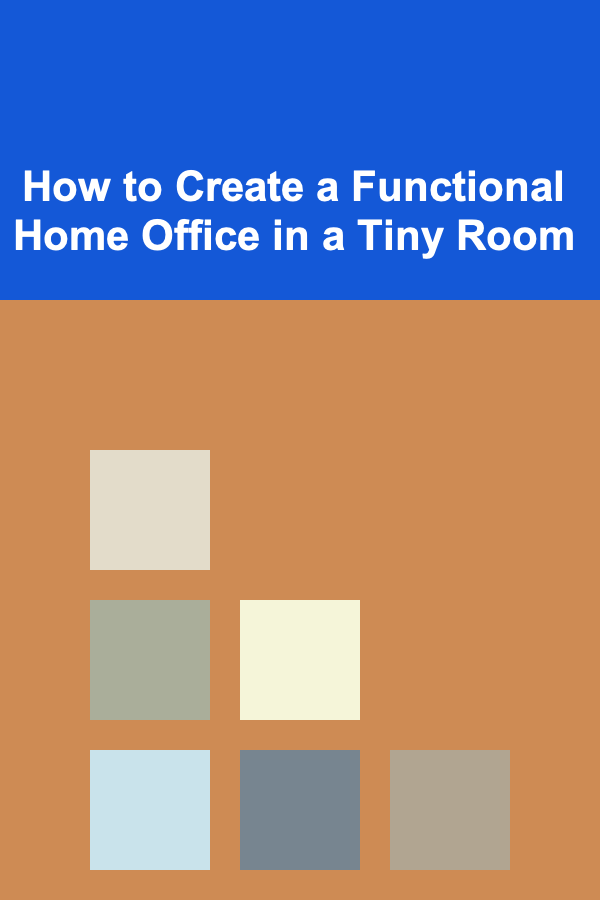
How to Create a Functional Home Office in a Tiny Room
ebook include PDF & Audio bundle (Micro Guide)
$12.99$10.99
Limited Time Offer! Order within the next:

In today's world, more people are finding themselves working from home. Whether you're a remote worker, a freelancer, or simply someone who needs a dedicated space for personal projects, creating a home office that's both functional and inspiring is essential. However, for many of us, space is a precious commodity, and turning a tiny room into a productive office can feel like a daunting task.
The good news is that with careful planning, creative solutions, and some organizational tips, you can design a home office that maximizes every inch of your tiny room. This guide will explore how to create a functional and efficient home office, even in the smallest of spaces.
Assess Your Space and Identify Key Needs
Before you start designing your home office, the first step is to evaluate the space you have. Measure your room, paying close attention to dimensions and layout possibilities. A tiny room may not offer a lot of flexibility, but by understanding the space you're working with, you can make smarter choices in terms of furniture and design.
Key Considerations:
- Room Dimensions: Take precise measurements of your room's width, length, and height. Even small changes in layout can make a big difference.
- Lighting: Good lighting is crucial for productivity and mental clarity. Note where natural light comes in, as well as where you may need additional lighting, like desk lamps or ceiling lights.
- Power Outlets: Take stock of where your electrical outlets are located, especially if you'll be using multiple devices like a computer, phone charger, and printer.
- Functionality: Consider the key tasks you'll be performing in the office. Will you be focusing on paperwork, creative work, or video conferencing? This will help determine your furniture and tech needs.
Maximize Vertical Space
In a small room, the goal is to use every available square inch, and one of the best ways to do this is by focusing on vertical space. Tall furniture, wall-mounted shelves, and floating desks are ideal solutions for keeping things off the floor and creating more room to move.
Floating Desks or Wall-Mounted Workstations
A floating desk is a great way to save space while maintaining functionality. Wall-mounted desks typically require less floor space and provide plenty of room underneath for additional storage or foot space. This setup gives you a clean, minimalist look while still providing the necessary surface area for your work.
- Desk Size: Choose a desk with a shallow depth, like a 24-inch or narrower option, to avoid crowding the room. Consider a desk with built-in shelves or hooks for extra storage.
- Wall-Mounted Shelves: Install shelves above your desk to hold office supplies, books, or decorative items. These shelves can hold everything from files to your favorite plants, helping you avoid clutter.
- Vertical Storage Units: Tall cabinets or shelving units can provide significant storage space without occupying much floor area. Consider options with drawers, cubbies, or baskets to keep your office supplies organized and hidden.
Hanging Storage and Hooks
In a small office, wall hooks can also be a game-changer. Use them to hang bags, headphones, or even a headset for virtual meetings. Hooks can even be used to store your coat or sweater, helping to keep the space tidy and organized.
- Over-the-Door Organizers: If your tiny room has a door, make use of it by installing an over-the-door rack or organizer. This is an ideal place to store office essentials like paper, pens, and cleaning supplies.
Opt for Multi-Functional Furniture
In small spaces, multifunctional furniture is essential. When choosing pieces for your home office, look for items that can serve more than one purpose. Multi-functional furniture can reduce clutter and make your space feel more flexible and adaptable.
Convertible Desks and Chairs
A desk with adjustable height features is one example of versatile furniture. If you prefer to switch between sitting and standing, a standing desk or an adjustable sit/stand desk can be a great option. You can use the same desk for both activities without needing additional furniture.
- Storage Desks: Some desks come with built-in storage, including drawers or filing cabinets, which help keep paperwork and office supplies organized. You can also find desks with additional shelves or built-in compartments for extra storage.
- Foldable Furniture: A foldable chair or table can be stored away when not in use, allowing you to reclaim the room for other purposes. Consider a foldable chair or compact desk that can be tucked away when you need more space for other activities.
Modular Storage Systems
Consider modular storage solutions that can be customized as your needs change. Modular shelving and storage units offer flexibility in terms of height, depth, and arrangement. You can also add or remove components as needed, depending on how your office evolves over time.
- Stackable Storage: Look for storage boxes, bins, or crates that can stack on top of each other. These are especially helpful for keeping papers, files, and supplies out of sight while maintaining accessibility.
Keep It Organized with Smart Storage Solutions
A clutter-free workspace is key to maintaining productivity, especially in a tiny room. In a small space, everything needs to have a designated place. Organize your supplies, documents, and equipment to avoid the room feeling chaotic.
Use Drawer Organizers
Drawer organizers are a great way to sort small office supplies like pens, paper clips, and notepads. Dividers can help compartmentalize your drawers, making it easier to access what you need without rifling through piles of items.
- Vertical Filing Systems: Instead of using traditional file cabinets, opt for vertical file organizers or hanging file systems. These take up less floor space and keep documents easily accessible.
- Cable Management: Keep cables tidy and out of sight with cable clips, ties, or cable boxes. This will not only reduce clutter but also prevent cables from becoming tangled or damaged.
Storage Baskets and Bins
Baskets and bins are great for storing office essentials like paper, printer ink, or tech gadgets. Label each container to make it easier to find items when you need them.
- Under-Desk Storage: If you have a traditional desk, use the space beneath it for additional storage. A set of baskets or a small filing cabinet can help you keep your office organized without taking up valuable floor space.
Incorporate Natural Light and Smart Lighting Solutions
Lighting is crucial in any office, but it becomes even more important when you're working in a small space. Natural light can create the illusion of more space and improve your mood and productivity. However, it's not always possible to rely solely on natural light, so incorporating smart lighting solutions is essential.
Use Natural Light to Your Advantage
Position your desk near a window if possible. The natural light will help make your small room feel larger and more open. Additionally, exposure to daylight helps maintain circadian rhythms, making you feel more energized throughout the day.
- Light-Reflecting Surfaces: Choose light-colored furniture and wall paint to reflect more light around the room. Light hues can make the space feel larger and brighter, even on cloudy days.
- Window Treatments: Use light, airy curtains that allow sunlight to filter through while maintaining some privacy. Avoid heavy drapes, as they can make the room feel closed off.
Invest in Task Lighting
In addition to natural light, consider investing in adjustable task lighting like desk lamps, wall sconces, or pendant lights. Task lighting is crucial for avoiding eye strain and making it easier to work during darker hours.
- LED Desk Lamps: Adjustable LED desk lamps are energy-efficient and provide customizable lighting. Choose a lamp with a flexible neck to direct light exactly where you need it.
- Smart Lighting: Smart bulbs or dimmable lighting can help you set the perfect ambiance depending on the time of day or task at hand. You can adjust the brightness and color temperature to suit your needs.
Create an Inspiring Environment
While functionality is key in a small office, don't forget to make the space inspiring. A well-designed workspace can boost creativity, increase motivation, and reduce stress.
Personalize with Décor
Even a small room can reflect your personality through thoughtful décor. Choose artwork, plants, or items that inspire you and make the space feel welcoming.
- Plants: Indoor plants not only improve air quality but also add a natural touch to your office. Consider low-maintenance plants like succulents, snake plants, or pothos, which thrive in low-light environments.
- Artwork or Inspirational Quotes: Hang a few pieces of artwork, photos, or framed quotes that resonate with you. These items can help make the space feel more personal and motivating.
- Minimalist Design: Since the space is small, a minimalist design is often the best approach. Choose simple, clean lines and avoid overcrowding the room with too much décor.
Design for Comfort and Wellness
A functional home office should also be a comfortable space. Working in a tiny room doesn't mean sacrificing comfort. Prioritize ergonomic furniture and wellness practices to maintain both physical and mental well-being.
Invest in an Ergonomic Chair
An ergonomic chair can make a significant difference in your comfort levels. Look for a chair with adjustable height, lumbar support, and armrests to ensure that you maintain good posture throughout the day.
- Chair Cushions: If your chair doesn't offer enough comfort, consider adding a cushion or lumbar support pillow to enhance your seating experience.
Promote Movement and Stretching
In a tiny room, you might not have space for a treadmill or yoga mat, but you can still incorporate movement into your day. Try standing while on calls or using a balance ball chair to engage your core.
- Stretch Breaks: Set reminders to take short breaks to stretch or walk around the room. Even in a small space, movement is essential for avoiding stiffness and maintaining focus.
Conclusion
Creating a functional home office in a tiny room is entirely possible with a little creativity, strategic planning, and smart design choices. By maximizing vertical space, using multifunctional furniture, staying organized, and ensuring comfort, you can turn any small room into a productive and inspiring workspace. Whether you're working from home full-time or need a space to focus on personal projects, these strategies will help you create an office that supports your productivity and well-being. With the right layout and thoughtful touches, your small home office can be both functional and a place you look forward to working in every day.
Reading More From Our Other Websites
- [Personal Care Tips 101] How to Apply Mascara for a Natural Everyday Look
- [Home Soundproofing 101] How to Soundproof Your Home for Musicians: Tips for Recording and Playing
- [Home Holiday Decoration 101] How to Create a Cozy Farmhouse Christmas Decor for a Warm Holiday Atmosphere
- [Home Lighting 101] How to Create a Home Theater Lighting Setup for the Ultimate Viewing Experience
- [Organization Tip 101] How to Utilize Drawer Liners for Extra Protection
- [Home Soundproofing 101] How to Block Road Noise from Entering Your Home with Effective Soundproofing
- [Home Rental Property 101] How to Use Technology to Streamline Your Home Rental Property Management
- [Home Storage Solution 101] How to Store Cleaning Supplies in a Convenient Yet Tidy Way
- [Personal Finance Management 101] How to Break Bad Financial Habits and Build Better Ones
- [Home Party Planning 101] How to Incorporate Personal Touches into Your Party Planning

How to Leverage Your Network for Charity Support
Read More
How to Plan for Kids' Expenses in Your Home Budget
Read More
Saving Money on Home Internet Security: Affordable Tools and Strategies
Read More
How to Use Your Natural Energy Cycles for Planning
Read More
Yoga for Weight Loss and Stress Relief: A Comprehensive Guide
Read More
How to Navigate Instrument Approaches Like a Pro
Read MoreOther Products

How to Leverage Your Network for Charity Support
Read More
How to Plan for Kids' Expenses in Your Home Budget
Read More
Saving Money on Home Internet Security: Affordable Tools and Strategies
Read More
How to Use Your Natural Energy Cycles for Planning
Read More
Yoga for Weight Loss and Stress Relief: A Comprehensive Guide
Read More